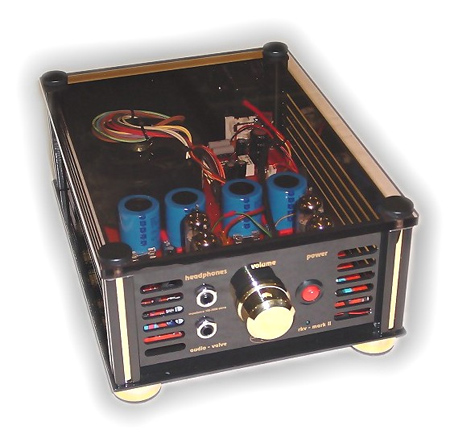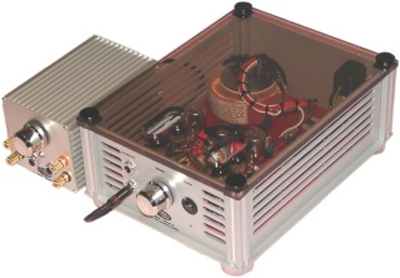You are reading the older HTML site
Positive Feedback ISSUE
15
september/october 2004
audio valve
RKV Mark II headphone amplifier
as reviewed by Carlo Flores

|
CARLO FLORES' SYSTEM
LOUDSPEAKERS
ELECTRONICS
SOURCES
CABLES
ACCESSORIES
|
Let me tell you one of the reasons I like Dr. Jan Meier. After he read my review of his HA-2 headphone amp, he told me that I favored tube sound (I do), and asked if I had heard the Audio Valve RKV Mark II. A week or so later, PFO received one for review. I do not know of another instance in which one manufacturer offered another's product for review, although I should point out that Dr. Meier distributes Audio Valve products in North America. Meier seems to care more about his customer's needs than he does about hyping his designs. I mention this because I consider the HA-2 the standard for performance/price, against which I must measure the RKV.
Audio Valve's RKV Mark II is an OTL tube amp that measures a little over 5 x 9 x 12 inches in size and is priced at $1050 shipped. According to Audio Valve's website (www.audiovalve), it was designed by Helmut Becker to drive any load between 32 and 2000 ohms, but it could not quietly drive my 40-ohm Grado HP-1 headphones without a transformer (an option packaged as the $180 Impedancer), so I used my Sennheiser HD580s. Finding replacements for the RKV's set of four Tungstram PCL805 tubes is said to be easy, although I believe that tube rollers will find limited options. The amp's piano black finish with gold trim is more garish than elegant—it would look sharp in Snoop's crib, but a picky girlfriend may give grief. Its paralleled pair of single-ended inputs means that it can act as a two-source headphone amplifier or function between a source and preamp. An IEC receptacle and two headphone jacks are included. The top lid is made of a transparent material and is secured with metal thumbscrews, which allows easy access to tubes and fuses as well as amorous glances at its sexy red PCBs.
There's a lot I like about the amp. It was so good during the first month that I felt seduced. I think of music reproduction as a three-part process—attack, body, and decay—and I give the RKV good marks in each. It has an almost lush sound, full but not bloated. Even when paired with an average-sounding digital source like my modified Sony CE-775, the amp contributed an analog-like reverb to strings. It sounded noticeably fatter and sexier than the HA-2. For example, Pulp's Intro—The Gift Recordings has lots of crazy riffs that sound electric and awesome with most amps, the HA-2 included, but dominating with the RKV. For you audiophiles, Norah Jones sounded huge.
I can't overstate that the RKV makes music sound damn good. It's all about midrange, bass, and decay, though I'm not saying that the high frequencies suffer, because they don't. I am not talking about impact or detail, but about finding the music. The word that comes quickest is "wet." Notes sound wet when played through the RKV. A groovy acoustic guitar, such as Jonathan Richman's, has adequate groove, which is an accomplishment for a system featuring the HD580s. I'm also talking about the kind of soundstage that makes me forget I'm wearing headphones.
Magnifying this is bass performance that pushed the Sennheisers to their limit. I prefer a quick midbass and a direct relationship between the lowering of frequency and a note's thickness, and the RKV gives me what I want. The Sonics' foundation, Serge Gainsbourg's pace, and Mos Def's beats just sounded right, and involved me as a listener. I've heard more expensive amps mess up the lower notes. Unlike them, the RKV ‘s separation between bass notes is distinct, and while their impact is somewhat weak, instruments have adequate weight. When the foundation of notes is this good, I find myself turning into a bass head.
What did I lose to get that scale? A great amp gives up very little, if anything. HA-2 doesn't even try to sound big, preferring to achieve frequency balance, and it offers Dr. Meier's cross-feed to recordings that need consolation. The RKV ignores audiophile sensibilities, offering gray backgrounds and little resolution at low levels. While the stage is very wide, placement within that stage is fuzzy at best. It's easy to focus on one instrument—to ride a stringed instrument or be caught in a piano—and get lost when listening to the RKV. However, place that instrument in relation to the others, and things turn messy. As with badly set up speakers, the image of each performer is soft and indistinct. People who want scale in a small room with reflection problems know what I'm talking about—the nuance is gone. Albums sound good, but hardly ever interesting. If you owned this amp, why would you invest in high-quality recordings when you cannot hear their full potential? This is a music lover's amp, not an audiophile's.
I have not mentioned my reference headphone source, the Audio Note 2.1x CD player, because it does not complement the RKV and the HD580. Instead, it yields an unbalanced but juicy sound, appealing at times (Nick Cave's piano in the song "Into My Arms") and irritating at others (Nick Cave and The Bad Seeds' album Murder Ballads). Unlike the HA-2, which mates well with even the most flavored sources, the RKV gets in the way. In the end, the RKV is a designer Band-Aid that will help a system that needs to add flesh to notes. It probably would have been great with my old reference, an Arcam Alpha 9, or other typically dry British sources. The RKV only disappears at moments, depending upon song and instrument. As much as I like this amp, I believe it has too many flaws—its inability to drive low-impedance headphones, its high noise floor, and its lack of balance—at $1195. The HA-2 can be the foundation of a system. Find the headphone you want and it'll drive it. Choose a flavored or unflavored source and you'll hear the characteristics the designer wants you to hear. It costs almost half as much, and it comes with cross-feed. For me, this just isn't a contest.

After about a month and a half of listening to the RKV, I received an Impedancer for review (to the left of the RKV above). The Impedancer is a passive device meant to match its load to its input. It is a stand-alone product that will work with other headphone amps. It has a small footprint, and will fit comfortably next to an RKV in a standard-width stand. The Impedancer's rotary bypass control is a gold knob that matches the RKV's volume knob. On the front face are gold-plated speaker binding posts, turning this into an integrated amplifier for high efficiency speakers, which I did not try. There are also two headphone outputs on the front face. Most importantly, the Impedancer allows listeners to use the RKV with the dynamic headphones that matter, including Joseph Grado's HP-1000 series and Sony's R-10s.
The Impedancer and RKV together are quieter than the RKV alone. I found that I listened at my lowest levels using the two together. Considering the price of cables nowadays, $180 makes the Impedancer a no-brainer, even when using high-impedance headphones. Nevertheless, the Impedancer did not drastically change my opinion of the RKV/HD580 combination. After listening to the RKV with my Grado HP-1s, I realized that the soft-sounding Sennheisers, paired with the RKV, were more mush than lush. While the HD580s' and RKV's flaws overlap, the HP-1s' focus and leading line gave a sense of balance. Side-to-side placement was better than adequate, and the RKV's depth was in proportion to the HP-1s' somewhat shallow stage. On some recordings—Tom Waits' Blue Valentine, Aimee Mann's Bachelor #2, and Dylan's Time Out Of Mind, to name a few—the combination yielded a haunting and spatially interesting sound. Perhaps it was more pretty than natural, but I like that. The HA-2, Headroom Max, or Sugden Headmaster amps don't make me sink into a song quite like the RKV can with certain recordings.
Everything that was good with the RKV stayed good with the Impedancer and the HP-1s, especially bass. This was where the lowered noise floor of the Impedancer made an impact. My perception was that the top was faster and the bottom thicker. Still, other amps can go lower, and I can only wonder how this amp would sound with a completely black background. Again, the HP-1s complemented this amplifier, and the combination rocked. Hell, I spent a day listening to The Sonics and The Zombies because this system rocked so much. Not many amps feed my love for distortion and wicked midbass.
Yet I would not call this amp fast. It does better with sultry electronica (Tricky's Maxinquaye) than with trippy and fast electronica (Aphex Twin). Transient information doesn't pop out of the black, as it does on quieter components. Are excellent macrodynamics worth the loss of microdynamics? Is scale more important than subtlety? The RKV will always sounds like the RKV. I listen to albums I know and things sound different. Then I think about how good womens' voices sound with this system, and I reach for a Joni Mitchell album. I see why so many like the RKV.
The Impedancer is a required option, even if using it means only that so you can divorce yourself from Sennheisers. That makes this a $1230 system. The RKV is at least the equal of the Headroom Max, though you will give up the Max's pitch-black background and winning linearity. I'd take the RKV over the Sugden Headmaster and many other amps, but I couldn't have it as my primary amp, and I don't think of it as a reference unit. Flavor doesn't matter unless the basics—again, black background, linearity, and separation—are addressed. The RKV, even with the Impedancer, only gets two correct. She's a nice change of pace, but not the girl I'd marry.
Update
After completing this review, I found out that an RKV Mark III is in the works. The Mark II is still available, but Positive Feedback is glad to pass along the first picture of its replacement. As you can see, the amp is still in the prototype stage. Dr. Meier told me that Helmut Becker has focused on low-impedance loads and a substantially lowered noise floor, eliminating the need for the Impedancer. As you can see, the input tubes are no longer the same as the output tubes, and while their type/family hasn't been released, they are more common than PL805s. This will be the first all-tube amp with cross-feed, and its price will be lower than the Mark II. While this is exciting, I am skeptical about getting everything I want at a lower price. Still, this may be our first glimpse of one of the great sub-$1000 headphone amps. Carlo Flores
Audio Valve
web address:
www.audiovalve
Meier Audio
web address:
http://home.t-online.de/home/meier-audio
